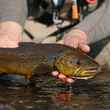No type of fly fishing is more demanding on an angler’s fly line than tropical saltwater fishing. For the most part, this is a function of the physical conditions and the challenging nature of the species that tropical saltwater anglers spend most of their time targeting.
For years, Airflo has been making my favorite saltwater fly lines. There are lots of very good saltwater lines out there these days, but in my experience, Airflo lines consistently shine in the tropics.
It seems like that this is mostly due to the fact that Airflo makes their lines using polyurethane, while all other fly line manufacturers use PVC (polyvinyl chloride). Polyurethane not only gives Airflo the ability to modify the stiffness of the plastic in its lines -- an aspect of crucial importance in the tropics where fly lines that are too soft will turn noodle limp and cast terribly -- without tampering with the stiffness of the line’s core, but also allows them to build lines with different levels of stiffness throughout the line (something Airflo calls Zone technology).
I have wholly unconfirmed suspicion that Airflo is building tropical saltwater lines that are a bit stiffer than other folks are and, for me, these lines typically cast better and behave better in warm, saltwater environments.
Chard's Tropical Punch, designed by saltwater casting guru and flats guide Bruce Chard, was created to address specific issues saltwater anglers face -- such as W-I-N-D -- and continues Airflo's track record of building excellent tropical saltwater lines.
What Works
Loads quickly
Saltwater line makers across the board have gotten very good at developing line tapers that quickly load fast saltwater fly rods. In a world where the window to deliver a fly to the target opens and closes in seconds, being able to quickly load your fly rod and shoot a cast with little or no false casting is imperative.
The stout belly helps quickly load fast rods like Sage’s SALT even on short presentations, which are more common in the tropics than most inexperienced saltwater anglers imagine them to be.
Carries well
Chard countered the aggressive front taper design by building in an extended, 19 foot rear taper that produces a line with a more balanced feel than other lines I’ve cast that seem to have somewhat similar design goals. Carrying longer lengths of line to deliver bigger casts can still be accomplished with nearly as much ease as lines with more traditional tapers (such as Airflo’s standard tropical lines like its SuperDRI Bonefish line).
Punch in the w-i-n-d
Airflo didn’t decide to call this line the tropical “punch” for no good reason. Chard’s taper design is a welcome one when the wind kicks up. Even on a blustery day on the flats, casts straight into the wind laid out straighter and turned over leaders more reliably than other lines did. Chard would likely attribute that latter fact to the Tropical Punch’s surprisingly short (2 foot) front taper, which Bruce says helps unload power into the leader.
Turns over heavy flies too
The short front taper isn’t only a boon in windy conditions, it is also a big asset with heavy flies, like lead-eyed crab patterns used in permit fishing. Most lines made for the tropics will turn over your average crab pattern relatively well, but many struggle badly when deeper water or other conditions require a heavier crab. Casting these heavy patterns in challenging conditions can be an absolute nightmare, especially for anglers that don’t spend a lot of time in the salt.
At Belize’s Turneffe Flats, anglers spend part of their time chasing permit in one of the Turneffe Atoll’s lagoons, where large schools of permit frequently gather in water that is a few feet deeper than conditions that are typical on the flats. This often calls for considerably heavier crab or shrimp flies, in order to quickly get the fly down to the bottom where the fish are plucking at prey in the turtle grass. In these situations, when asked to do so, the Tropical Punch turned over these heavy patterns more effectively than other lines in the boat did. To be fair, turning over such heavy patterns is notably unpleasant regardless of the line running through the guides, but the Tropical Punch does make doing so noticeably easier.

Shoots forever
This can be said of all of Airflo’s saltwater lines but is no doubt worth mentioning here. Airflo’s stiff tropical construction and Ridge technology deliver. Put the power into your cast and this line will shoot as far as you can reasonably expect it to.
Bulletproof
Like all polyurethane lines, worries about ultraviolet radiation (lines cracking the sun) and damage from chemicals like those in sunscreen and DEET aren’t a worry, and that’s no small thing when you’re investing $85 in a fly line.
What Doesn’t
Heavyweight consequences
Despite the fact that the Tropical Punch’s extended rear taper allows for carrying long lines very well, there are still consequences to its taper design which gives it its “punchy” name sake. Whether it is the slightly overweighted belly or the compact front taper, as lines get long, casts lack a bit of grace when compared to lines with more traditional saltwater tapers.
This is a reality that stood out more when test casting the line rather than fishing it, so its consequences in the real world of stalking bonefish may not be as pronounced. But, if you’re fishing in dependable conditions that require particularly delicate presentations, you’ll likely be able to produce one more reliably with a more traditional line.
Quiet, but do you really care?
Airflo really likes to tout that its lines, with their Ridge technology, are quiet compared to other textured lines. Most anglers will know what knife they’re trying to turn by pointing this out, and while it is one worth turning in regards to lines that are commonly used in more placid environments -- such as when trout fishing with tiny dry flies on glass-still, gently flowing spring creeks -- I'm guessing it is of little concern in the saltwater world where waves crash and winds howl and barracuda are swimming about, for god's sake.
But hey, if you feel you've got a leg up, I guess you might as well shake it.
Final Word
As noted, I love fishing Airflo’s lines in the salt. Fly lines are all about technology these days, and Airflo’s technologies -- like it’s use of polyurethane, zone technology and ridge construction -- seem to serve them particularly well when building lines for use in tropical saltwater environments.
Chard’s Tropical Punch is no exception, and its unique design may be a problem solver for many an angler, especially beginners and other anglers that don’t have the privilege of fishing a large number of days honing their saltwater casting.































Comments